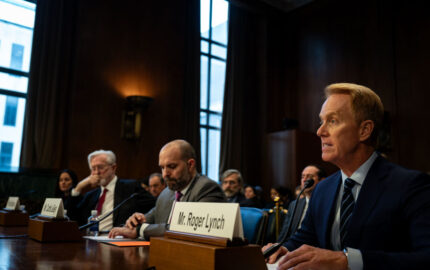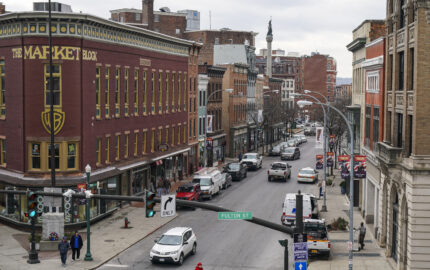
Visual Journalism
Photojournalism is changing, propelled by newsroom budget cuts, multimedia possibilities, and the ubiquity of digital images. In Visual Journalism, photojournalists write about emerging digital business strategies and their efforts to expand the reach of their photographs online and on gallery walls. They also share ideas about how to fund projects of personal passion and societal value. Their words tell vital stories about how they do their work; slideshows of their photographs—exclusive to our Web site—and multimedia presentations convey their visual stories. Read and watch as the future of photojournalism unfolds.
RELATED ARTICLE
"A Story Rooted in a Community Gives Voice to Its People"
- David CampbellFew journalistic forms have had their death foretold more often than photojournalism. Ever since weekly pictorial magazines like Life and Look closed their doors in the 1970’s, the demise of photojournalism has been declared at regular intervals. Recent upheavals in the media economy, signaled by the talk of the “death of newspapers,” have given rise in some circles to a new round of lamentation positing a dismal future for visual storytellers.
At the same time, the billions of still photographs produced annually, circulated globally, and consumed eagerly suggest no shortage of producers and no end to the collective desire to see our experiences portrayed RELATED ARTICLE
"Journey to a New Beginning"
- Ed Kashiphotographically. In this vein, the renowned photographer Ed Kashi told a December 2009 forum at the London College of Communication on the new ecology of photojournalism that he saw the makings of a new golden age for photojournalism.
How can we understand this optimistic view of an uncertain future given all of the negative assessments of photojournalism in recent years?
Although the Internet is not responsible for all the problems of contemporary media, we need to appreciate how it has fundamentally reordered the media economy. After all, the Web did not, in Clay Shirky’s terms, simply introduce a new competitor into the old media ecosystem but created a fundamentally different ecosystem by severing any automatic link between the creation of information and its distribution. The Web also collapsed the cost of publishing and eliminated barriers to the formation of distributed networks. Given this, we live in a remarkable time where our ability to communicate, share, collaborate and act has expanded beyond the limits of traditional institutions and established practices.
In this context, the claim that photojournalism is dying is actually about the collapse of traditional systems of distribution and payment rather than the end of visual forms of information. Some see the demise of print distribution and direct editorial funding as delivering a fatal blow to the practice of photojournalism. This isn’t the case, but at the same time no one should diminish the difficulties this change has produced.
Thinking about how photographers should proceed requires a realistic assessment of the past. In-depth photographic projects and challenging documentary work have always been difficult to fund directly. If there was a time when all the majority of photojournalists did was wait for well-paid commissions to produce important work for print outlets, that time is long past. And it won’t be returning regardless of an upturn in advertising or new paid content models.
Even so, I share Kashi’s reasoned optimism. The revolutions in the media economy driven by the Web’s cutting of the link between information and distribution provide photojournalism with new opportunities. Photographers can’t ignore other modes of distribution—print media, books, exhibitions, etc.—but the Web is the only platform that offers a growing audience for their stories and an efficient means of distribution. To be on the Web—and to be visual—now means multimedia storytelling, from photo galleries to stand-alone sites with stills, audio, video and text together. To tell stories to a Web audience requires finding compelling combinations of sound and image.
The Web Changes Everything
To say all of this is to state the blindingly obvious. Photographers have been using digital media for years in these ways. But what is at stake now is something more than having a shop window in which to display one’s wares on the Web. It involves seeing oneself as a publisher of content and a participant in a distributed story, the form of which helps reshape the content of the story. Rather than producing a single image or small series of images to be sold into another person’s story, multimedia provides numerous advantages for visual storytellers:
RELATED ARTICLE
"Failing to Harness the Web’s Visual Promise"
- Fred RitchinThese benefits intersect with what has been identified as the emerging atomic unit of information on the Web. With a shift from “article” to “topic” will be the move from “single picture” or “photo essay” to “visual story” as part of the multidimensional narratives that make up a topic. This visual story will be set in context, linked, updated and distributed across the Web. Importantly, this involves much more than a shift from taking stills to producing videos. It is about rethinking the capacity to tell stories in line with what Fred Ritchin calls a “new visual journalism.”
This move from photojournalism to visual journalism, from photography to Ritchin’s “hyperphotography” does not involve either giving up on the still image or abandoning the documentary function of photography. It might employ a variety of new media formats, such as those used by Flyp magazine, or it might take advantage of devices like the Apple iPad. None of these will save photojournalism or any other part of the news business. What they offer are new modes of distribution that use the power of photography to help structure a multidimensional story.
What’s been a bit mysterious—and in some ways worrisome—in this transition has been the relative silence of the photographic press in exploring in any detail the impact—especially the economic effect—of these media revolutions on its constituency. What commentary has occurred on influential Web sites such as The Digital Journalist has pined for the way things were and hoped for a return to those days. In the search for payment models, the impulse has been to say “Let’s do what music did with iTunes,” without digging more deeply to discover why what worked for songs doesn’t fit with all photos.
So how will photojournalists be paid to produce their stories? To start with, it will be essential for photographers to adopt a new mindset if they are to find a productive response to this challenge. Forget all the fuss around the Rupert Murdoch-inspired debate about paying for content or The New York Times’s proposed metering system or Steven Brill’s consortium approach. Even if any of these work (and that is far from certain), no photographers should pin their career hopes on a new subscription-funded editorial paymaster emerging.
The successful visual journalist in the new media economy is going to be someone who embraces the logic of the Web’s ecology. This will mean using the ease of publication and circulation to construct and connect with a community of interest around their projects and practice. Photographers who understand they are publishers as well as producers, for whom engaging a loyal community is more valuable than chasing a mass audience, will be in a powerful position. They will be the ones who use social media in combination with traditional tools to activate partnerships with other interested parties to fund their stories, host their stories, circulate their stories, and engage with their stories.
The vital role that photojournalists play as our visual witnesses can be—and I’d argue will be—the basis for asserting their economic value in the years ahead. How they get paid has already changed considerably, with an abrupt shift away from once-reliable magazine and newspaper coffers toward an inventive array of sources that revolve around projects but are not limited to the sale of individual images. What is shared by many of the leading photojournalists of our day is a commitment to using the best digital technology has to offer to distribute their work as widely and as effectively as possible. In doing this, they will be creating a new, if still uncertain, pathway for photojournalism.
David Campbell is a professor of cultural and political geography at Durham University in the United Kingdom, where he is associated with the Durham Centre for Advanced Photography Studies. He writes about photography, multimedia and politics at www.david-campbell.org/blog and works as a multimedia producer in collaboration with photographers.
"A Story Rooted in a Community Gives Voice to Its People"
- David CampbellFew journalistic forms have had their death foretold more often than photojournalism. Ever since weekly pictorial magazines like Life and Look closed their doors in the 1970’s, the demise of photojournalism has been declared at regular intervals. Recent upheavals in the media economy, signaled by the talk of the “death of newspapers,” have given rise in some circles to a new round of lamentation positing a dismal future for visual storytellers.
At the same time, the billions of still photographs produced annually, circulated globally, and consumed eagerly suggest no shortage of producers and no end to the collective desire to see our experiences portrayed RELATED ARTICLE
"Journey to a New Beginning"
- Ed Kashiphotographically. In this vein, the renowned photographer Ed Kashi told a December 2009 forum at the London College of Communication on the new ecology of photojournalism that he saw the makings of a new golden age for photojournalism.
How can we understand this optimistic view of an uncertain future given all of the negative assessments of photojournalism in recent years?
Although the Internet is not responsible for all the problems of contemporary media, we need to appreciate how it has fundamentally reordered the media economy. After all, the Web did not, in Clay Shirky’s terms, simply introduce a new competitor into the old media ecosystem but created a fundamentally different ecosystem by severing any automatic link between the creation of information and its distribution. The Web also collapsed the cost of publishing and eliminated barriers to the formation of distributed networks. Given this, we live in a remarkable time where our ability to communicate, share, collaborate and act has expanded beyond the limits of traditional institutions and established practices.
In this context, the claim that photojournalism is dying is actually about the collapse of traditional systems of distribution and payment rather than the end of visual forms of information. Some see the demise of print distribution and direct editorial funding as delivering a fatal blow to the practice of photojournalism. This isn’t the case, but at the same time no one should diminish the difficulties this change has produced.
Thinking about how photographers should proceed requires a realistic assessment of the past. In-depth photographic projects and challenging documentary work have always been difficult to fund directly. If there was a time when all the majority of photojournalists did was wait for well-paid commissions to produce important work for print outlets, that time is long past. And it won’t be returning regardless of an upturn in advertising or new paid content models.
Even so, I share Kashi’s reasoned optimism. The revolutions in the media economy driven by the Web’s cutting of the link between information and distribution provide photojournalism with new opportunities. Photographers can’t ignore other modes of distribution—print media, books, exhibitions, etc.—but the Web is the only platform that offers a growing audience for their stories and an efficient means of distribution. To be on the Web—and to be visual—now means multimedia storytelling, from photo galleries to stand-alone sites with stills, audio, video and text together. To tell stories to a Web audience requires finding compelling combinations of sound and image.
The Web Changes Everything
To say all of this is to state the blindingly obvious. Photographers have been using digital media for years in these ways. But what is at stake now is something more than having a shop window in which to display one’s wares on the Web. It involves seeing oneself as a publisher of content and a participant in a distributed story, the form of which helps reshape the content of the story. Rather than producing a single image or small series of images to be sold into another person’s story, multimedia provides numerous advantages for visual storytellers:
- It allows photographers to focus on a story and produce more content with greater control over how those pictures are presented.
- The meaning of visual stories can be directed through the construction of a narrative that draws on sound and text as well as photographs and video.
- It overcomes restrictions on getting longer and more complex stories published for a global audience, especially younger generations who do not consume traditional media.
- It is an effective response to the conceptual challenge of how to provide context for a photograph.
- It can overcome photojournalism’s objectification of people by giving subjects their own voice.
RELATED ARTICLE
"Failing to Harness the Web’s Visual Promise"
- Fred RitchinThese benefits intersect with what has been identified as the emerging atomic unit of information on the Web. With a shift from “article” to “topic” will be the move from “single picture” or “photo essay” to “visual story” as part of the multidimensional narratives that make up a topic. This visual story will be set in context, linked, updated and distributed across the Web. Importantly, this involves much more than a shift from taking stills to producing videos. It is about rethinking the capacity to tell stories in line with what Fred Ritchin calls a “new visual journalism.”
This move from photojournalism to visual journalism, from photography to Ritchin’s “hyperphotography” does not involve either giving up on the still image or abandoning the documentary function of photography. It might employ a variety of new media formats, such as those used by Flyp magazine, or it might take advantage of devices like the Apple iPad. None of these will save photojournalism or any other part of the news business. What they offer are new modes of distribution that use the power of photography to help structure a multidimensional story.
What’s been a bit mysterious—and in some ways worrisome—in this transition has been the relative silence of the photographic press in exploring in any detail the impact—especially the economic effect—of these media revolutions on its constituency. What commentary has occurred on influential Web sites such as The Digital Journalist has pined for the way things were and hoped for a return to those days. In the search for payment models, the impulse has been to say “Let’s do what music did with iTunes,” without digging more deeply to discover why what worked for songs doesn’t fit with all photos.
So how will photojournalists be paid to produce their stories? To start with, it will be essential for photographers to adopt a new mindset if they are to find a productive response to this challenge. Forget all the fuss around the Rupert Murdoch-inspired debate about paying for content or The New York Times’s proposed metering system or Steven Brill’s consortium approach. Even if any of these work (and that is far from certain), no photographers should pin their career hopes on a new subscription-funded editorial paymaster emerging.
The successful visual journalist in the new media economy is going to be someone who embraces the logic of the Web’s ecology. This will mean using the ease of publication and circulation to construct and connect with a community of interest around their projects and practice. Photographers who understand they are publishers as well as producers, for whom engaging a loyal community is more valuable than chasing a mass audience, will be in a powerful position. They will be the ones who use social media in combination with traditional tools to activate partnerships with other interested parties to fund their stories, host their stories, circulate their stories, and engage with their stories.
The vital role that photojournalists play as our visual witnesses can be—and I’d argue will be—the basis for asserting their economic value in the years ahead. How they get paid has already changed considerably, with an abrupt shift away from once-reliable magazine and newspaper coffers toward an inventive array of sources that revolve around projects but are not limited to the sale of individual images. What is shared by many of the leading photojournalists of our day is a commitment to using the best digital technology has to offer to distribute their work as widely and as effectively as possible. In doing this, they will be creating a new, if still uncertain, pathway for photojournalism.
David Campbell is a professor of cultural and political geography at Durham University in the United Kingdom, where he is associated with the Durham Centre for Advanced Photography Studies. He writes about photography, multimedia and politics at www.david-campbell.org/blog and works as a multimedia producer in collaboration with photographers.


